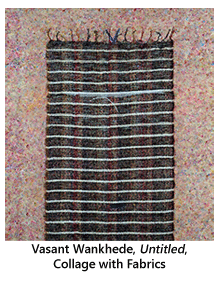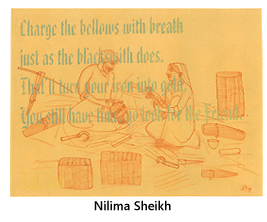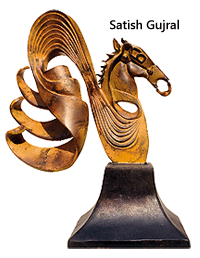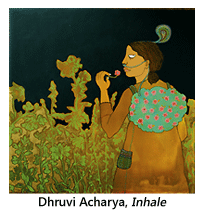- Publisher's Note
- Editorial
- Memories of a Master
- The Gallery as Print Studio
- Printer as Pedagogue
- Perspectives of an Outsider
- Ghosts in the Machines
- Digitalization and Contesting Digitalization
- The Body in Woodcut
- Evoking Symbol and Redefining Space
- The Almanac of Debian Delight
- Permanent State of Suspension
- Perspectives on Survival
- A Look at Printmakers from Australia, Canada and Bangladesh
- Atin Basak: His Artistic Pursuit
- Chor Bazaar, Mumbai
- Didn't We Often Wish We Lived in a Time of Ancient Glory
- The Buddhist Heritage of Pakistan: Art of Gandhara, the Asia Society Museum, New York
- Slivery Facets of Golden Diamonds from Golconda
- Ulysse Nardin: Keepers of History
- Venice Biennale
- What Happened with “Deconstruction India”
- Publication of Graphic Folio by the Members of Society of Contemporary Artists, 2010
- A Blitzkrieg of Creative Impulses
- Let's Paint the Sky Red- A Solo Show of Late Artist Manjit Bawa
- Raghu Rai: Invocation to India - A Variegated Matrix of the Human Predicament
- Rise of Prints
- The Story So Far
- What Happened and What's Forthcoming
- Art Bengaluru
- Art Events Kolkata
- Musings from Chennai
- Mumbai Art Sighting
- Few Printmakers from North East: A Brief Glance at the Contemporary Practices
- Previews
- In the News
ART news & views
Mumbai Art Sighting
Volume: 4 Issue No: 20 Month: 9 Year: 2011
August – September 2011
by Jasmine Shah Varma
Abstract thread
Vasant Wankhede is not a name that has headlined auction results or etched in major abstract art exhibitions. Yet practically every abstractionist in Mumbai reveres him and has been inspired by him at some point of the other. Many attended the opening of his show Divine Play at Gallery Art & Soul in August.
Yet practically every abstractionist in Mumbai reveres him and has been inspired by him at some point of the other. Many attended the opening of his show Divine Play at Gallery Art & Soul in August.
After more than 45 years of devoting himself to art practice Wankhede announced that this solo show would be his last presentation because of failing health. The artist born in 1936 is one of those few artists who remained low profile in and, in spite of the decade of art boom in India, making this exhibition a special occasion. He exhibited collages with fabric and watercolours on paper made over the years.
The use of found fabric to create spontaneous lines, forms and every gesture highlights this veteran artist's experimentations. In spite of the rigid and bulky nature of fabric in comparison to the lightness and suppleness of pigments, Wankhede has achieved fluidity, precision and transparency in his abstractions. The play of the warp and weft, the printed patterns on the fabric and the collage of different pieces do not appear deliberate but display an easy transition from mere pieces of cloth to abstract expressions of the artist's state of mind.
Wankhede says his works are not pre-planned and the selection of fabric is not deliberate. He has been meditating in fabric collages since the last two decades making his visual vocabulary lucid and well-structured.  These abstractions are contemplations on life. Rather than speak eloquently about spirituality or philosophical wisdom, the low profile artist prefers to say his paintings are about nothing. We are left to our own devices to appreciate his refined technique and the possible meaning his esoteric annotations. The show concluded on August 30.
These abstractions are contemplations on life. Rather than speak eloquently about spirituality or philosophical wisdom, the low profile artist prefers to say his paintings are about nothing. We are left to our own devices to appreciate his refined technique and the possible meaning his esoteric annotations. The show concluded on August 30.
Mini becomes giant
The annual Harmony Art Show took place after a one year break at Coomaraswamy Hall (Prince of Wales Museum). After featuring Indian miniature traditions in the 2009 edition, this edition saw independent curator Gayatri Sinha focus on Fabular Bodies: New Narratives in the Art of the Miniature. It featured the practice of appropriating yesteryear's miniature painting techniques by 24 contemporary mainstream fine artists expressing current themes and concerns. The paintings, sculptures and photography based works in the show were not necessarily small format works. In fact works by artists Suhasini Kejriwal and T Venkanna were almost 10 feet canvases.
Using techniques and painterly traditions of the past to voice contemporary concerns provides historical depth and a visual dialogue that traverses time. The painterly language itself becomes the part of the content as seen in the works of Nilima Sheikh and Lavanya Mani. Sheikh's miniature drawings reflected nostalgically on artisanal and craft traditions which provided livelihood to the ordinary folks in the past. Mani's works are made of dyed fabric, embroidery and printing. The carefully chosen motifs she uses to build the narrative are rooted in India's colonial history.
part of the content as seen in the works of Nilima Sheikh and Lavanya Mani. Sheikh's miniature drawings reflected nostalgically on artisanal and craft traditions which provided livelihood to the ordinary folks in the past. Mani's works are made of dyed fabric, embroidery and printing. The carefully chosen motifs she uses to build the narrative are rooted in India's colonial history.
Among the sculptures, Chintan Upadhyay's largish sculpture of a baby's bald head is painted in the style of Rajasthani miniature painting. At the other end of the spectrum Pooja Iranna reflects on urban architectural landscape with ziggurat-style buildings made of thousands of staple pins.
Comic book and graphic novel cultures were revisited by artists such as Chitra Ganesh and Dhruvi Acharya to express their personal narratives. N S Harsha created a series of his observation in small format line drawings of how the unfortunate sleep. His poignant suite of paperwork covers genders, professions, religions and ages of his subjects.
While the concerns and themes of individual artists featured in the show varied, the curatorial focus was on the importance of an artist's efforts to build visual vocabulary towards expressing his/her concerns by  linking to the vast pool of imagery rooted in the country's past traditions and popular culture. The exhibition concluded on August 14.
linking to the vast pool of imagery rooted in the country's past traditions and popular culture. The exhibition concluded on August 14.
Among other shows
Gallery Maskara turned into artist T Venkanna's open studio. The young artist who straddles various mediums including painting, printing and performance art, set up his print-making equipment in the gallery's premises to create a body of work in full view of walk-in audience from July 19. While some of his previous etchings are on display in the gallery, at end of this exercise the new works made will also be up for exhibition. Meanwhile, this initiative is helping spread awareness on the fascinating processes of etchings and woodcut techniques besides offering the rare opportunity to see an artist at work. The open studio concludes on September 14.

Art Musings is showcasing sculptures by five artists until September 14 in an exhibition titled Cube. While the works of established sculptors such as Satish Gujral, S Nandagopal and KS Radhakrishnan are familiar to most, it is intriguing to see the experiments in three dimensional arts by painters Sakti Burman and Paresh Maity. On view are works in bronze, copper, brass and bell metal.
In a rare viewing Mumbai got to see the works of art historian Ratan Parimoo. The exhibition featured works made between 1956 and 1960 in style characterised by an idyllic perspective on life, people and the places he lived in or visited. On view were oils on canvas depicting scenes such as a crowded Baroda railway station, a group of monkeys, views of house on Dal Lake, Khajuraho temple complex, village belles at work and children at play among other such themes. The exhibition was presented by Ahmedabad's Marvel Art Gallery at Museum Art Gallery in Mumbai. The show concluded on August 28.